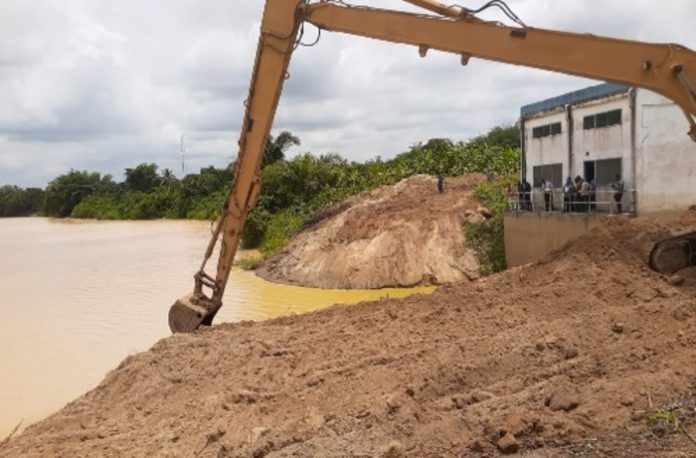
Two water treatment plants on River Pra in the Western and Central regions face possible shut down.
Experts, technicians and academicians at a workshop on water bodies restoration on Wednesday painted grim pictures of water bodies in the country.
Stakeholders in the conference room at the University of Cape Coast deliberated for hours on how to restore our dying polluted water bodies.
They came from the Water Resources Commission, Environmental Protection Agency, the Public Utility Regulatory Commission and security agencies and the media. One question was loud. Why would we choose gold over water?
It cannot be farfetched to conclude that water is the essential for life. Participants indicated that the actions of communities and stakeholders did not depict this, that water remain a necessity for our existence.
Indeed, our water bodies are being wantonly polluted in search of minerals that we can live without at the expense of something wisdom has equate to life itself — water.
Impunity
The impunity with which such deadly deeds are committed is scary and our seeming helplessness gives great course for worrying.
The Regional Chief Manager of the Ghana Water Limited (GWL), Seth Atiapah, indicated that Chang fang machines, the weapons of destruction are often seen lined up some of our riverbanks with unbridled audacity.
The effect
Some communities especially in the Central and Western regions are beginning to feel the effect hard.
Residents carry gallons in such of water as GWL production at Sekyere Hemang has already been cut by 30 percent.
Indeed, the GWL has expressed grave concern at the high turbidity of the River Pra at Daboase and Sekyere in the Western and Central regions respectfully, warning that if stringent measures were not taken the plant could be shout out completely.
The stakeholder workshop on Wednesday was part of measures to find solutions to the problem.
River Pra
The river Pra that serves as a source for the Daboase Water Treatment plant and the Sekyere Hemang is facing grave challenges.
An associate Professor of Water and Environmental Quality at the University of Cape Coast, Prof Albert Ebo Duncan, said the problem was not about Sekyere Hemang or Daboase, “it’s about the management of our water bodies across the country”.
He indicated that though 70 per cent of the earth was water, two thirds of the world’s water is saline.
Out of the fresh water, two thirds was in glaciers and ice caps.
Of that fresh water usable, he noted, 20 percent was located in inaccessible areas. It means only 0.13 percent of the 2.5 percent fresh water is actually available for use and requires proper management for sustainability.
In Africa, Prof Duncan, said about 30 percent water run offs occurs in the Congo basin. He noted that while the use of water had increased due to population, the volume of water had not increased making the situation dire.
He said the demand for food increases require water for increased irrigation.
He said irrigation farming takes 70 percent of the world available water, leaving 0.04 per cent available fresh water for all other activities including domestic, commercial and industrial purposes, saying scarcity of water also affects food security.
Reforms
According to Prof Duncan, past reforms had been geared towards water resource development and not management, indicating that the Integrated Water Resource Management policy had not worked as expected.
He said efforts should go beyond consultation to the communities to get them to protect the river bodies.
Appeal to conscience
He said it obvious that force would not work to get the illegal miners to do the right thing, adding that they must be appealed to their conscience.
He also observed the institutions must be properly coordinated using multi-prone approaches a s stakeholders particularly traditional authorities to effectively manage water resources in the communities.
Turbidity all time high
The Regional Chief Manager of the Ghana Water Limited, Seth Atiapah, said turbidity of water at Sekyere Hemang intake plant reached an all-time high of 13,000 NTU on Tuesday, March 19, 2024.
“Normally at the level we needed to shut down,” he stated.
The situation, he said had compelled the GWL to quadruple its treatment chemical to get the water potable.
He called on all stakeholders, chiefs, community, media, security agencies and others to collaborate the water company to help save the water bodies.
He also called for enforcement and compliance of robust regulatory frameworks and environmental and mining laws to ensure help save water bodies.
“These days galamseyers have become so notorious, rich and strong that if you arrest them the next day they are out,” he stated.
He said water was continuously becoming a scare commodity adding “if galamsey is not stopped water supply to Sekondi-Takoradi, Cape Coast Elmina and surrounding communities will be seriously challenged.”
He said the next world war could be possible fought on water.
Human rights issue
The Deputy Managing Director of the GWL, Peter De-veer said the havoc caused by illegal miners on water bodies had become a human rights issue as our very existence was being threatened.
He asked that more efforts were made to bring perpetrators to book.
He indicated that the operational burden of the illegal miners was enormous.
He noted that pumps at the treatment plant which were expected to be changed after 25 years were already breaking down due to silt coming into the intake point.
A Professor of Environmental Chemistry, Prof Daniel Essumang who chaired the workshop, said there was a lot of data on mining and its impact of water resources to inform policy intervention and called for more effective engagement between academia and other stakeholders especially policy makers in efforts to restore the polluted and dying water bodies.
The stakeholders called for strengthened integrated water resource management framework to get our water resources restored.
As the world celebrates World Water Day on the theme “Water for peace” it is expected that stakeholders would follow through with well-coordinated approaches to help restore the state of the water bodies.
ALSO READ:






